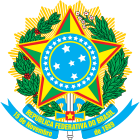1934 Brazilian parliamentary election
| This article is part of a series on the |
 |
|---|
Parliamentary elections were held in Brazil on 14 October 1934 to elect members of the Chamber of Deputies and state legislatures.[1]
Background[edit]
Following the Brazilian Revolution of 1930, a constitutional assembly was elected in 1933 and drew up a new constitution, which came into force on 16 July 1934.[2] It provided for a federal state with a bicameral parliament consisting of a 300-member Chamber of Deputies (of which 250 were directly elected and 50 selected by union and employer bodies) and a Senate consisting of two members from each state, who would be elected by state legislatures.[2][3]
After the constitution was promulgated, the Assembly was converted into a Chamber of Deputies and elected Getúlio Vargas as president the following day.[2]
Electoral system[edit]
The 250 directly elected members were elected by open list proportional representation, with states acting as constituencies.[3][4] Voters could cast preferential votes for candidates from multiple parties.[4]
Results[edit]
Of the 250 elected members, 142 were supporters of Vargas, 76 were from the opposition and 32 were independents.[5]
References[edit]
- ^ C. Peixoto-Mehrtens (2010). Urban Space and National Identity in Early Twentieth Century São Paulo, Brazil: Crafting Modernity. p. 2008.
- ^ a b c Joseph Smith (2014). A History of Brazil. p. 143.
- ^ a b Brazil, a Country Study. 1983. p. 41.
- ^ a b Jairo Nicolau (2007). "The open-list electoral system in Brazil" (PDF). Dados. 3.
- ^ John W. F. Dulles (2014). Vargas of Brazil: A Political Biography. p. 157.
